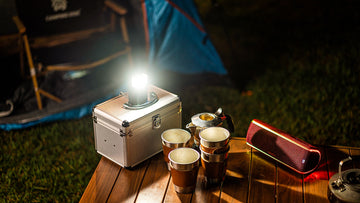
The soft, flickering glow of a candle has captivated humans for centuries. Even in today's world of modern lighting, there is something about candlelight that is simply irreplaceable. The way it casts dancing shadows on walls, creates a cozy atmosphere, and brings a sense of tranquility to a room is unmatched by any other light source.
One of the things that makes candlelight so special is its lumen output. Lumens are a unit of measurement that quantifies the brightness of a light source. Unlike the outdated wattage measurement, which only measures the amount of energy a light source consumes, lumens directly correlate to the perceived brightness. This means that lumens provide a more accurate representation of how much light a light source is actually emitting.
A typical small candle produces about 12-15 lumens. This is not very bright compared to other light sources, such as LED bulbs or fluorescent lights. However, the soft, gentle glow of candlelight is what makes it so appealing. It creates a warm, inviting atmosphere that is perfect for romantic dinners, meditation, or simply relaxing at home.
In addition to the lumen output, there are a few other factors that can affect the brightness of a candle. The type of wax used, the presence of additives or scents, the size and shape of the candle, and even external environmental factors like drafts can all impact the overall luminosity. This is why it is important to experiment with different types of candles to find the ones that produce the desired amount of light.
Beyond its simple function as a light source, candlelight also has a significant emotional impact. The soft, warm glow of candlelight has been shown to reduce stress and anxiety, promote feelings of well-being, and even enhance creativity. This is why candles are often used in spas, yoga studios, and other settings where people are looking to relax and de-stress.
Of course, candles are not just for relaxation. They can also be used to create a festive or romantic atmosphere. Whether you are setting the mood for a special occasion or simply enjoying a quiet evening at home, candles can add a touch of elegance and sophistication to any space.
So, how many lumens does a candle produce? It depends on a variety of factors, but the average small candle produces about 12-15 lumens. While this is not very bright compared to other light sources, the soft, gentle glow of candlelight is what makes it so appealing. Candlelight has a long and storied history, and it continues to be a popular choice for both practical and decorative purposes. Whether you are looking for a way to relax, create a romantic atmosphere, or simply add a touch of elegance to your home, candles are a versatile and timeless option.
One of the things that makes candlelight so special is its lumen output. Lumens are a unit of measurement that quantifies the brightness of a light source. Unlike the outdated wattage measurement, which only measures the amount of energy a light source consumes, lumens directly correlate to the perceived brightness. This means that lumens provide a more accurate representation of how much light a light source is actually emitting.
A typical small candle produces about 12-15 lumens. This is not very bright compared to other light sources, such as LED bulbs or fluorescent lights. However, the soft, gentle glow of candlelight is what makes it so appealing. It creates a warm, inviting atmosphere that is perfect for romantic dinners, meditation, or simply relaxing at home.
In addition to the lumen output, there are a few other factors that can affect the brightness of a candle. The type of wax used, the presence of additives or scents, the size and shape of the candle, and even external environmental factors like drafts can all impact the overall luminosity. This is why it is important to experiment with different types of candles to find the ones that produce the desired amount of light.
Beyond its simple function as a light source, candlelight also has a significant emotional impact. The soft, warm glow of candlelight has been shown to reduce stress and anxiety, promote feelings of well-being, and even enhance creativity. This is why candles are often used in spas, yoga studios, and other settings where people are looking to relax and de-stress.
Of course, candles are not just for relaxation. They can also be used to create a festive or romantic atmosphere. Whether you are setting the mood for a special occasion or simply enjoying a quiet evening at home, candles can add a touch of elegance and sophistication to any space.
So, how many lumens does a candle produce? It depends on a variety of factors, but the average small candle produces about 12-15 lumens. While this is not very bright compared to other light sources, the soft, gentle glow of candlelight is what makes it so appealing. Candlelight has a long and storied history, and it continues to be a popular choice for both practical and decorative purposes. Whether you are looking for a way to relax, create a romantic atmosphere, or simply add a touch of elegance to your home, candles are a versatile and timeless option.
Tags:
Related Articles




